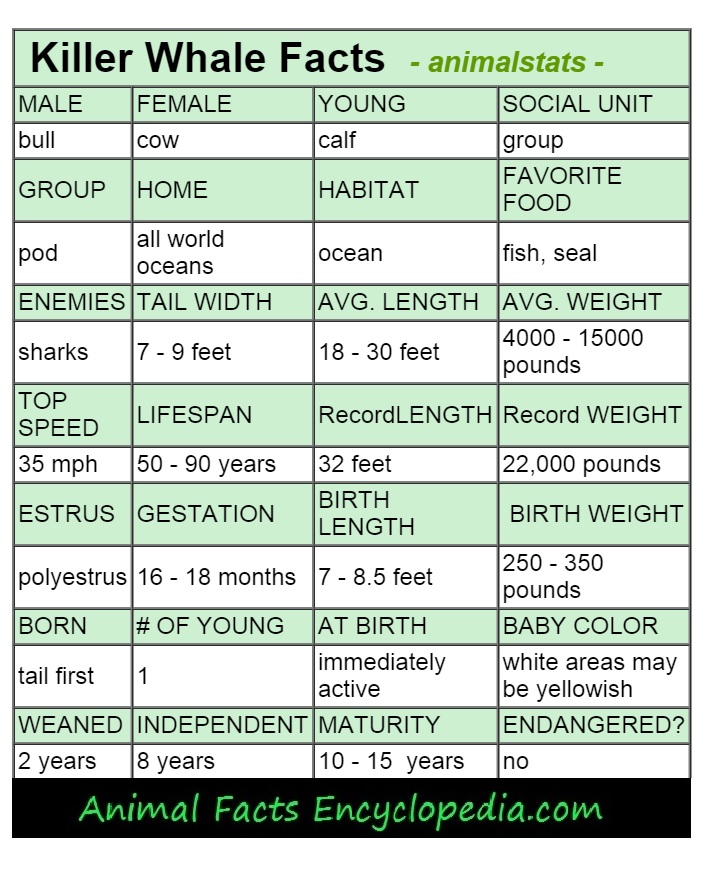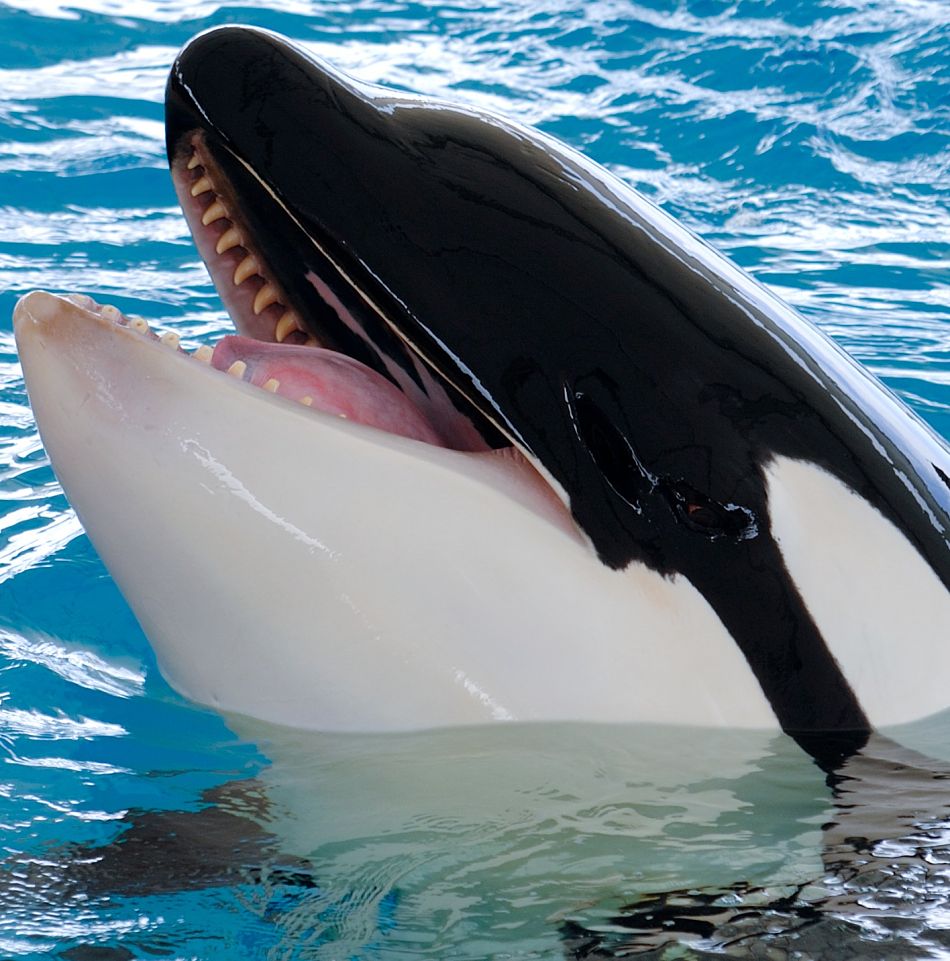killer whale Facts
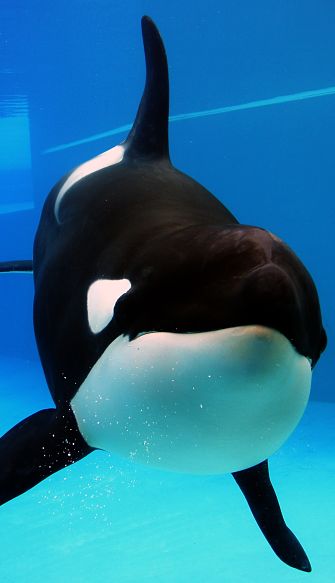 Portrait of a Killer Whale
Portrait of a Killer WhaleThe killer whale is actually the largest member of the dolphin or delphinedae family, which is over 35 different species of toothed whales, including the bottlenose dolphin.
Most of the largest dolphin species are referred to simply as whales, including pilot whales and of course killer whales, also known as orcas.
Killer whales are fully aquatic mammals that spend their entire lives underwater. They only need to breath air from the surface once every 5 to 10 minutes using the blow hole at the top of their heads which is like a large nostril.
They are found in all of the oceans of the world, and are populous even in the colder waters of the Arctic and Antarctic oceans.
The killer whale, or orca, is highly intelligent and extremely social. Killer whales live in family groups called "pods" which consist of adult males and females and calves of various ages. Pods usually include between 6 and 30 individuals, but like the bottlenose dolphin, the killer whales social structure is complicated, and pods may come together forming groups of over 200 whales, within which all the individuals recognize and socialize with each other.
Social contact and interaction are critical to all whale species, and the killer whale craves stimulation from its family, peers, and close friends.
Orcas are massive animals with males as large as 30 ft long (the largest recorded was a male measuring 32 feet long and weighing over 22,000 pounds) and require up to 500 pounds of food a day.
They are completely carnivorous and consume amazing amounts of small fish such as herring, larger fish like tuna and sharks, and marine mammals like seals, and even polar bears.
Pods of killer whales work together and use multiple techniques to hunt and will use their powerful tails called "flukes" as weapons. The term "killer" whale is probably due to the fact that pods of killer whales will hunt together and kill other whale species as well, including blue whales as large as 70 feet in length.
Whales don't have gills and can't breathe underwater. They do not breathe at all when submerged, and when they surface they must make a conscious effort to take a breath.
Because their breathing is not automatic, only one hemisphere of the whales brain goes to sleep at a time, the other half stays awake, with one eye open, to take in a breath every 5 minutes or so.
Killer whales have huge brains that are designed very differently from our own. Not only does their brain include entire regions that ours do not, but the areas of the brain known to encompass emotional thought and response are larger, percentage wise, in the brain of the killer whale than in any other animal.- Killer Whale Facts.
the killer whale and sense of self
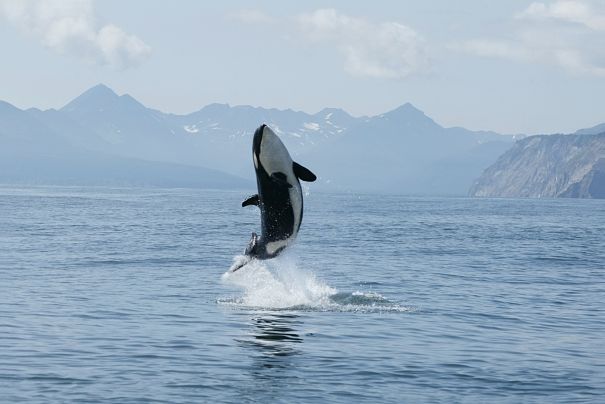
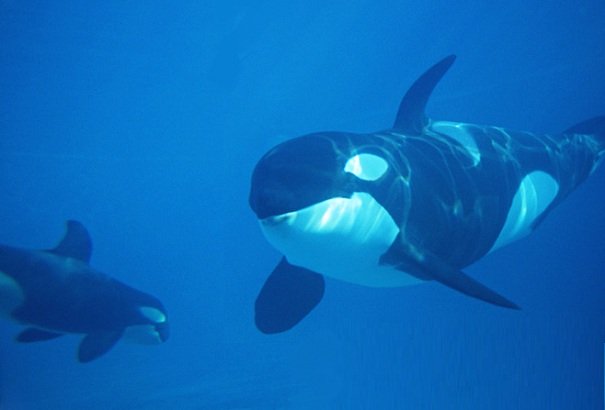
There has long been the perception that a "sense of self" is a uniquely human experience. Recent work with primates, whales and elephants however, suggest that they too, have a sense of self.
In the simplest test, animals faces or heads are marked, and their reaction to their reflection in a mirror subsequently observed.
Our brilliant and wonderful domestic dogs do not pass this test, but the great apes, the elephants and the dolphins do.
Beyond what that may suggest, is another sense that many believe exists only in whales and dolphins. It is sometimes referred to as a "distributed" sense of self, and suggests that all the whales in a pod, and in particular within their matrilineal family unit, have a combined "self" so closely connected emotionally, that the physical state of one affects all.
This may be a the reason behind the otherwise complete mystery of mass strandings and beachings, where entire pods of seemingly healthy whales swim out of the water, cast themselves ashore, and ultimately die.
A clearer connection researchers can point to are the numerous examples of perfectly healthy adult male killer whales under long-term observation in wild pods, who simply stop eating and die immediately after their mother has passed away.
The possibility that whales may have a sense of self beyond that of an individual is also suggested in how they interact when traveling, how they react when an individual is detained, attacked, or missing, and their reluctance, or even refusal to remove themselves from danger in certain situations.
This behavior is what allowed for the capture of entire pods of whales during the 1960's and 70's.
There is no "scatter" response that one sees with rodents and carnivores, but more a "herding" response, with a strong sense of staying together when danger is near.
It is believed that whales were once land animals, probably similar to ungulids like cows and camels, and when evolution brought them back to the sea, their herding instinct didn't just migrate with them, it became super-sized.
The sleeping behavior of killer whales gives hints of this. The members of the pod will form a tight circle, and their breathing and movements will synchronize. In unison they take several breaths at the surface, and then submerge for a period of time before surfacing again.
The time spent submerged increases as the "sleep" becomes deeper, but the movements are always in unison. Pods resting like this will avoid boats as a unit during this process while half of their brains are asleep.
The cohesion is astounding and unlike anything in the animal kingdom.
Whales have entire structures in their brains that do not exist in any land mammal. Some of these are adaptions to sea life, some are very specifically related to their emotional state, and may be the concrete physical testimonial to suggestions of a higher conscious state, or a "distributed" sense of self among whales.
See more about the curious brain structure of the killer whale further down this page under the heading "How Intelligent are Killer Whales?" - Killer Whale Facts
 orcas in action
orcas in actionkiller whale lifestyle and reproduction
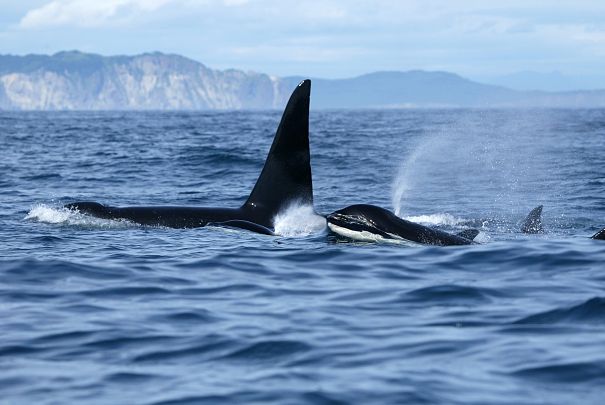 killer whale mother and baby
killer whale mother and baby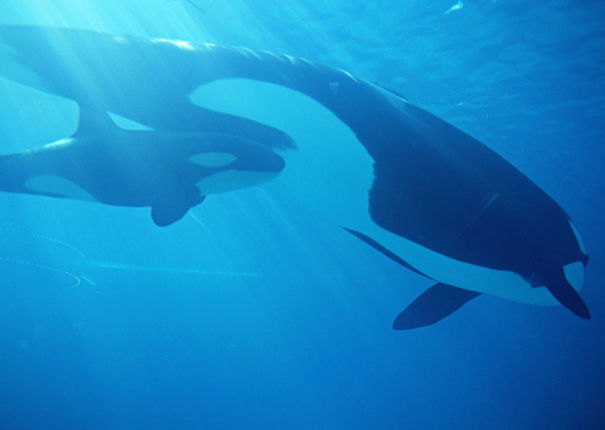 orca mother and calf
orca mother and calfAlthough the killer whale is currently recognized as one species, there is a tremendous variation in lifestyle among the population. Some whale pods are permanent residents in their territory. Resident pods have strong family bonds that are matrilineal in form, meaning a females offspring remain with her for life, and the offspring of her female young the same.
Males stay in their mothers pod and help raise the young within that family, but only mate with females outside the pod. This keeps the gene pool vibrant.
The second form is the transient pod. These whales travel in smaller groups and the family bond is less powerful. They are transient not just in territory but in group dynamic, and individuals of this type of whale have more of a "fission-fusion" lifestyle, with ever changing group dynamics.
The most striking thing about the transient whales is the difference in diet from that of the resident pods. Transient whales eat almost exclusively marine mammals as opposed to the largely fish diet of the residents. Seal, walrus, sea lion, and even polar bear are on the menu.
These whales hunt in unison and have been observed creating waves to disrupt animals on ice floes, beaching themselves to snare sea lions, and hunting like a wolf pack to kill and devour creatures as gigantic as blue whales.
The third type is the offshore pod. This is a group of which little is known due to the fact that they live far offshore and hunt schools of fish in deep water.
The offshore killer whales have been seen in huge pods of up to 200 individuals. The whales themselves are smaller than the other types, and seem to be the most genetically different.
Female killer whales are poly-estrus and become sexually active when they reach about 14 years old. They are promiscuous and have relationships with multiple partners.
 killer whale moms and babies
killer whale moms and babiesThe pregnancy lasts about 17 months and produces one calf. The calf is usually born tail first, and must move quickly to the surface to take its first breaths. It is very active almost immediately and swims close to its mothers flank where she can draft the baby along in her wake, known as a "slipstream". This also keeps the baby in an ideal position to nurse, which it must do while on the move. The entire pod assists in the well being of the calf.
Baby whales learn their mothers dialect very slowly and begin to speak the specific language of their pod, It takes two years before a youngster has a full repertoire of vocalizations.
As they mature, males will venture away from their family pod for rendezvous with females from other families, but they always return, and the resident killer whales family unit is one of the most constant and stable in the animal kingdom. - Killer Whale Facts

the quest for big air
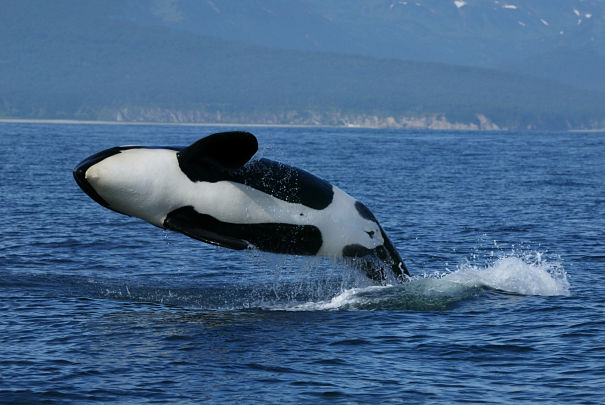 orca breach
orca breachWe've all marveled at trained whales leaping into the air at the blast of a whistle, but getting airborne seems to be a natural desire of all dolphins and whales.
Even the largest species of whales like humpbacks and blue whales engage in the exciting activity called "breaching". The question is why?
Scientists have debated for years on this subject, suggesting that leaping dolphins or whales are clearing parasites off of their bodies, looking around for flocks of seagulls that might indicate a school of fish in the distance, or announcing their presence to those nearby.
Given these animals astounding intellect, maybe they are just enjoying the thrill of exertion, engaging in sport as you or I might if our bodies allowed.
Maybe its just fun! -Killer Whale Facts
whale songs and echolocation
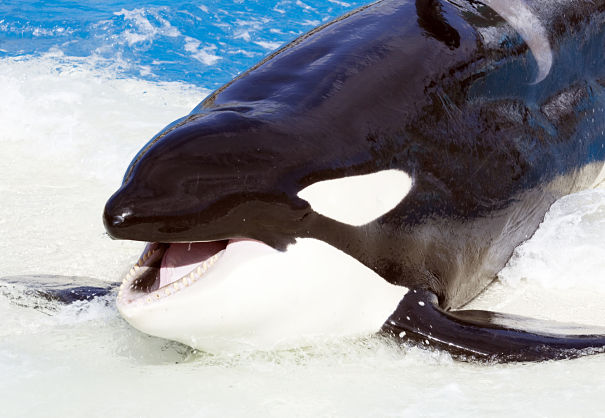

All dolphins and whales have a blow hole at the top of the head through which they breathe air from the surface. The blow hole is effectively a single nostril. Within the blow hole are delicate folds of skin known as "phonic lips" that create all the different clicks that whales use to communicate.
The whistle sounds are produced by the larynx - so whales can create more than one sound at a time. Whales have distinct voices, calls and languages, and communicate with sounds at some frequencies that can't be detected by the human ear.
They chatter constantly among themselves and each pod communicates with a different dialect - a distinct set of sounds that are markedly unique.
However when they talk to other pods they use a more communal language. When listening to recorded "conversations" of different pods of whales, even people who have no familiarity with whale calls can easily distinguish between the pods.
To put this in perspective - imagine all the dogs on Maple Street speak to each other exclusively with howls, the dogs on Oak Street talk to each other with growls, and the dogs on Poplar Street talk to each other with traditional barks.
Now imagine that when a dog from Maple street runs into a dog from Poplar Street they speak to each other by whining.
As bright as we know dogs are, we can use them to demonstrate the difference between animals using "calls" and the fact that whales use language.
Killer whales that are separated by great distances have completely different dialects. When analyzing Icelandic and Norwegian killer whale pods, researchers were able to distinguish 24 different calls made by the Icelandic population and 23 different calls made by the Norwegian whales, yet the two populations did not share any of the same calls.
Whales even have different "singing" voices from their everyday "speaking" voices. Almost like having a "phone voice".
In addition to the sounds they use to communicate with each other, whales use clicks to "echo locate" as bats do. They send clicking sounds out and can gauge an objects size and distance by the echoes that bounce off of it. This is how whales find their way around in deeper waters where there is little light. -Killer Whale Facts
how intelligent is a killer whale?
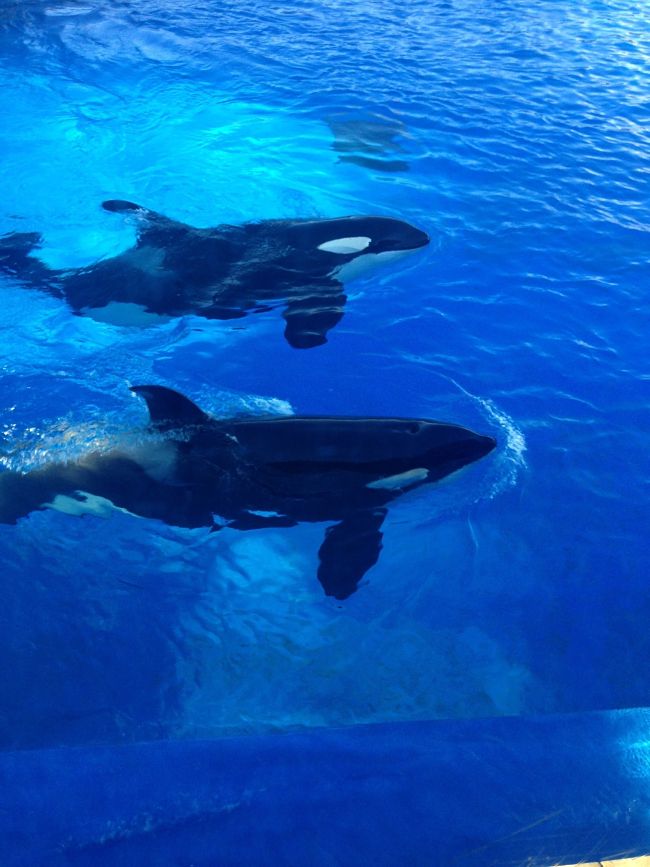
Killer whales kept in captivity have given us great insight into their intelligence. Killer whales can understand hand signals, vocal cues, and symbols on flashcards. Experiments have shown that they recognize themselves in mirrors and even have some understanding of numbers.
Without hands and opposable thumbs, whales have been observed making and using tools in the wild. A particular family of Dolphins has been observed wrapping pieces of sponge around their noses to protect them while they forage on the rough sea floor.
New mother whales have even been recorded using unique sounds when communicating with their offspring that they never use in communication with adult whales.
Is it "baby talk"? Well, that would certainly seem to be an emotional conclusion to draw from that information, but considering the results of MRI scans on the brains of killer whales, it might not be far off.
Within the brain, neurologists believe the area called the limbic system is responsible for the processing of all emotions. A whales brain contains an extra lobe of tissue immediately adjacent to their limbic system and neocortex
Named the paralimbic lobe, it is a massive brain structure that human beings do not possess. The paralimbic lobe is an outgrowth of the very areas of the brain that are known to control communication and social emotions in all other mammals.
It is entirely possible, based on the fact that whales have an entire structure in the emotional regions of the brain that no other mammals have, that they experience feelings, social connections and emotions such as love, grief and joy on a level that human beings can't even imagine. - Killer Whale Facts
the blackfish-seaworld controversy
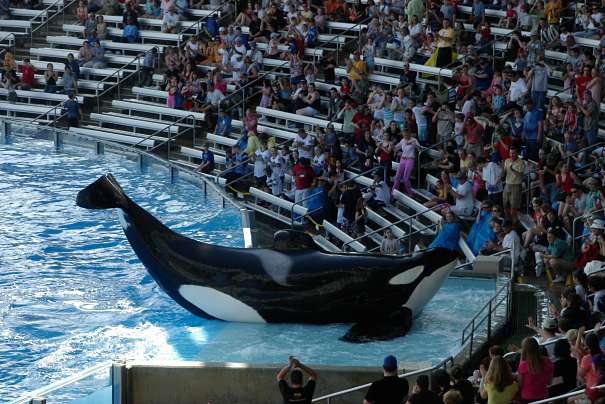 Tillikum at Seaworld
Tillikum at SeaworldWhales are so complex, emotional and clearly intelligent, that even the thought of holding them in captivity should not be considered.
The recent documentary "Blackfish" goes into detail about the unfortunate circumstances under which killer whales are held captive and forced to perform tricks in order to get fed.
It focuses on a massive male killer whale named Tilikum, displayed as "Shamu" at Seaworld. This one captive whale has murdered three separate human beings.
Housed in concrete pools, separated from family members, often separated from their children, killer whales held in captivity have endured so much mental anguish on a daily basis that many of them simply loose their minds.
Living a life enslaved, devoid of all of the pleasures available to wild whales - the freedom to travel for miles at a time without encountering a concrete wall, the joy of socializing with dozens of friends and family members, the thrill of hunting and choosing meals, the experience of a normal sex life, all deprived, some of these animals simply go insane.
Several trainers have lost their lives to whales that have lost their minds in captivity, dozens more have been injured as whales strike out in vain.
What we should realize most is that these trainers, no matter their motivation, are the captors, and killer whales like Tilikum are the captive, forlorn and ultimately helpless.
There has never been any record of a killer whale in the wild causing the death of a human being. -Killer Whale Facts

a few more killer whale facts
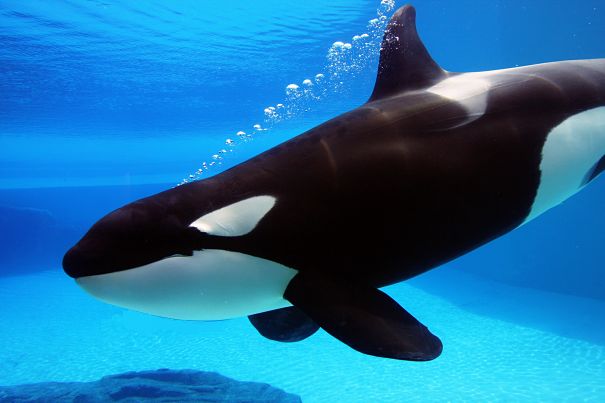 orca underwater
orca underwater- The killer whale is a actually the largest species of dolphin.
- Killer whales stick their heads straight out of the water and inspect the world above the sea in an activity called "spyhopping"
- Killer whales are also known as "orcas" and by Inuit communities as "blackfish"
- The killer whales top speed is almost 35 mph
- Killer whales sleep with 1/2 their brain at a time!
- The whale has a structure in its brain to process emotions that no other animal has - including human beings
- Killer whales may actually be several different species
- The killer whale is one of the few animals to be born tail first - Killer Whale Facts.
Scientific Classification:
| Killer Whale Facts - animalstats - | |||
|---|---|---|---|
| MALE | FEMALE | YOUNG | SOCIAL UNIT |
| bull | cow | calf | group |
| GROUP | HOME | HABITAT | FAVORITE FOOD |
| pod | all world oceans | ocean | fish, seal |
| ENEMIES | TAIL WIDTH | AVG. LENGTH | AVG. WEIGHT |
| sharks | 7 - 9 feet | 18 - 30 feet | 4000 - 15000 pounds |
| TOP SPEED | LIFESPAN | RecordLENGTH | Record WEIGHT |
| 35 mph | 50 - 90 years | 32 feet | 22,000 pounds |
| ESTRUS | GESTATION | BIRTH LENGTH | BIRTH WEIGHT |
| polyestrus | 16 - 18 months | 7 - 8.5 feet | 250 - 350 pounds |
| BORN | # OF YOUNG | AT BIRTH | BABY COLOR |
| tail first | 1 | immediately active | white areas may be yellowish |
| WEANED | INDEPENDENT | MATURITY | ENDANGERED? |
| 2 years | 8 years | 10 - 15 years | no |
see more animal extreme closeups
Recent Articles
-
African Animals - Animal Facts Encyclopedia
Oct 11, 16 10:27 PM
African Animals facts photos and videos..Africa is a wonderland for animal lovers, and a schoolroom for anyone who wants to learn about nature, beauty and the rhythm of life -
Baboon Facts - Animal Facts Encyclopedia
Oct 11, 16 10:26 PM
Baboon facts, photos, videos and information - Baboons are very distinctive looking monkeys with long, dog-like snouts and close set eyes. -
Great Apes Facts - Animal Facts Encyclopedia
Oct 11, 16 10:25 PM
Great apes facts, photos and videos..Human beings did not evolve from chimpanzees, modern chimps and gorillas do not appear in the fossil records until much more recently than homo sapiens..
